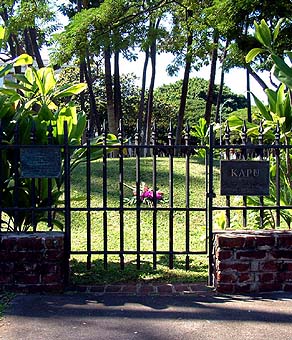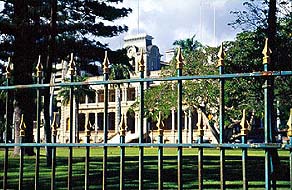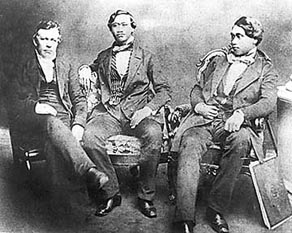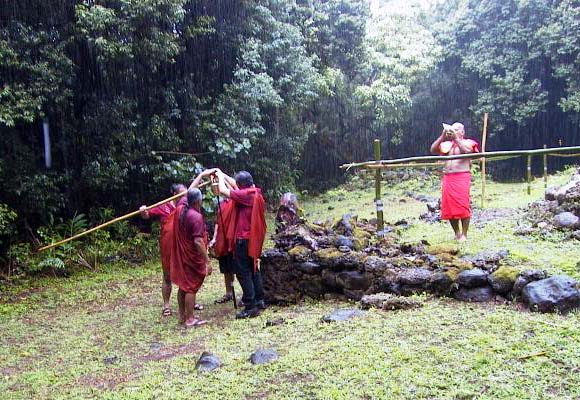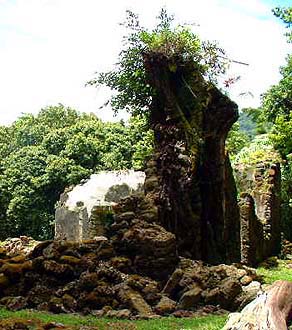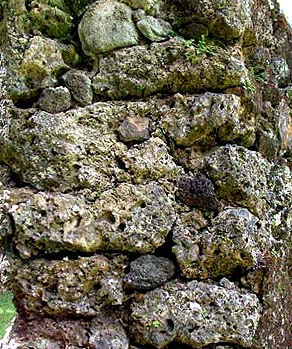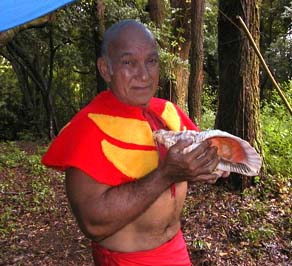 |
 |
 |
|||||||||||||||||||||
|
|
|
|
|
|
|
|
|
||||||||||||||||
|
|
|||||||||||||||||||||||
|
|
|
|
"The mound." Nearby is a small stone altar or ahu. Read about it here.
|
|
| "Our group Sacred Times, Sacred Places decided to malama the mound, Pohukaina," Lynette says. "We approached the friends of ‘Iolani Palace and asked for permission, and they gave it to us, and then we approached the State Department of Land and Natural Resources [DLNR], and asked them permission, which they didn’t give us. What they wanted to know was if we were a 501(c)3 federally-recognized non-profit, and actually they wanted us to go through the process of becoming legitimate for them, which we didn’t do, and have never done."
|
||
|
|
||
|
"It's about taking responsibility to malama a place, and no one was at Pohukaina -- the DLNR had responsibility for it, but we felt that they weren’t doing it very well, or very often. The ti plants were dying. And also we had concern about how they entered. I think that the State doesn’t care about protocol. I think they just walk in and out like it was nothing; it was really impersonal for them. "But it was personal for us. So we proceeded to malama the royal mound. We called in Kumu Keola Lake’s halau to find out what would be the proper protocol for entering and exiting every single time, and we got that. So as far as we were concerned, we went through the process -- of knowing the protocols, and practicing them."
|
|
"Pohukaina has been an important place for the chiefs from way before ‘Iolani Palace. Even before the Monarchy, it was a burial place. There's a lot written about who was buried there, and who is no longer buried there. Though a lot of those bones were removed to Mauna ‘Ala, a lot of them are still there. The whole area around the Palace that looks like a park, all the way to the library, is a burial site. There are bones everywhere. "And the mound area is where they put the chiefs. They took most of the bones away intact, and the moved them with ceremony. But those that had already crumbled, they're still there. We know for sure which ones were buried there, and we have a list of names of whose remains are still there."
|
|
|
|
"Jim Bartels shared with us a list of all of the remains. I typed it all out and I took it down with me, and all of us who gathered -- because you have to do some sort of ceremony before you go in anyway -- we read their names. In honor of them, and recognizing that they were still here, we did that. Of course, it has significance, and I think people should be careful, because the reading of the names can constitute a calling of them. "But we do it with full recognition of what it is that we do, because the mound itself is the focus of so many ceremonies and gatherings. The Royal Order of Kamehameha goes there, all kinds of people go there, and they circle that area, and they do ceremonies. And I know that there have been some interesting things that have happened there, that I haven't witnessed, but have been made in reports. That's one of the interesting things about that place. "Because we are at the Palace, we also malama the Queen, because she lived there. She’s still in the Palace, and we recognize that. And we have learned that a lot of the gatherings in resistance to Annexation happened at Pohukaina."
|
|
|
|
|
Bill Maioho explains the connection between Pohukaina and Hawaiian resistance to annexation: "At the time of the overthrow of King Kamehameha III by Paulet in 1840, when Lord Paulet took Hawai‘i and wanted to make it an English domain, at that time Paulet had all these kinds of documents and so forth, being written and signed by Kamehameha III. "What they did was, they heard that Admiral Thomas was in Chile. Gerrit Judd went into the mausoleum building, late at night. There, he used the coffin of Ka‘ahumanu as his desk, and he sat on the treasury of Hawai‘i -- chest of monies belonging to the government. They had hidden it from Paulet inside the mausoleum building. And because the building did not have windows, they couldn’t see candlelight. Judd was in there writing to Admiral Thomas, and telling him these things that had been happening. And Thomas received that, because they also smuggled it out of Hawai‘i to a ship captain and told him to go to Chile, and paid him. Admiral Thomas came to Hawai‘i, and Paulet was out, and they restored Hawai‘i to Kamehameha III. "So that mausoleum has some real history, about saving Hawai‘i. And I don’t think Judd really understood, that the mana of everybody inside that mausoleum building was placed inside that document, in his hand, in his writing, and thoughts, and everything. They helped Hawai‘i to get restored."
|
||
|
|
||
|
Lighting the torches at Kaniakapupu.
|
||
|
Meanwhile, up at Kaniakapupu, changes were taking place. Back when Clarence Ching first took on saving the site, more of the walls of the structure were standing, but over the years they just were allowed to fall apart. "So one thing led to another," says Lynette, "and we started doing exploratory field trips to Kaniakapupu. Mel came on board because of his connection to Pu‘u Kohola, and also because he reveres ali‘i, and he believes as we all do that there is a responsibility on us, because we’re the ones that are here to maintain that place." Mel recalls, "One day I was asked to come there by a preservation group. When I came into that area, I saw faces on every rock, big and small, and all of them were sad. It's hard to explain what happens to me when I'm up there. I understand what happened, so the kaumaha is on me. I have the responsibility up there to make things pono. "The spirits of our ancestors are really present there. That's some of the driving force that makes people volunteer, hands-on, doing the work to preserve this site. We need people with hands to save the place."
|
||
|
|
||
|
"Kaniakapupu represents a segment of time relating to Kauikeaouli’s brother (Liholiho), and of course his father, who fought that battle and led everybody, which ended the fight for supremacy. Because I’m connected to Kamehameha, of that line, that’s why Kaniakapupu to me is really important, and is something that have dedicated effort on my part, for my life, to do whatever I can do to save the place for the yet unborn. "I know sometimes my wife, she worries what I do up there. I not only talk about it, I’m up there physically with the chain saw. I guess sometimes, I have to think about what I’m doing, at my age. But at the same time, I’ve got this strength, I don’t know where it comes from; if I’m there, I have the extra strength. I can work all day from 9 o'clock to 3 or 4 in the afternoon, and come home. When I get on the bed, there are little aches and pains here and there, but in the morning, I’m ready to go again."
|
| "I always know that the mana of my ancestors is there with me, because I feel that there is something that I need to do, which is why my life was spared so many times. Kaniakapupu is a small place in this larger lele of Luakaha, which is the Crown lands of the ali‘i. I went there and I have become responsible for what has come towards me. I know I have a bigger responsibility to Kaniakapupu, and I’ve got to see it to the end, where there is pono. "For me, I feel that that’s special, like I belong there. And I don’t know whether it’s coming from the place itself. I always feel it in the wind, and I know that element is present, the element coming from the ground and all around me. And I know that others feel the same thing too. "
|
|
|
|
"One time I went over there, I was sketching the place, just thinking how are we going to treat this place? After all, this was the king’s place. Should we hide it, or should we expose it? And I think, on the other side, if we expose it, with protocol, then we would get respect from the tour groups. We have one guy that brings tourists over there on a really selective basis, he helps us. When he comes up here he respects -- he does his own protocol. “I think for now people want it quiet, that’s why we kind of set up a protocol, so everybody knows, there is protocol. Whenever we come up here to clean, there are always prayers, to ask permission. With the protocol in a place like that, people get more respect. One time I went up there, this family was inside there, the kids were jumping off through the windows. I had a hard time with that."
|
| "On Kamehameha III’s birthday, March 17th I think, we first gathered up there for a ceremony," Lynette recalls. "About 25 of us, and it was interesting because it was raining the whole time. We went specifically to do a torch-lighting ceremony. The Na Koa from Pu‘u Kohola came, and we had built a kind of a bamboo enclosure, and made room for torches on each corner, and the Na Koa did their ceremony, their chanting, and then proceeded to light the torches. It was a chicken-skin experience. "All this time it is pouring rain heavily. We even had a cake, because it was his birthday we brought a cake up there and we shared food in the rain, under the little tent, with 25 people trying to jam under this little shelter. It was kind of funny and fun, but very serious."
|
|
|
|
|
|
"When Mel talks about the future, he’s talking about reviving some of those practices that that place was a rest house for Kauikeaouli, and those people he worked with, but it was also a party place. If you want to have a party, this is a place to have it, and I think that’s what Mel envisions for the future — that we recognize that we enjoyed celebrations — that ceremony was a large part of our lives, but the ceremony took place in particular places. There were certain places where people tended to congregate for ceremony and celebration. So for us, I think the first thing is to make people understand what it is that we’re doing up there, and commit to doing that. And then, move forward." Two important developments continue to honor and maintain the traditions that mark this valley, and we invite you to read more about them. Mel has moved forward in organizing an annual march, commemorating the Battle of Nu‘uanu and revering those lost on both sides. In a special page honoring this effort, we have asked Mel to tell the story in his own words. Read about the ceremony.
|
||
|
|
||
| |
| |
|
|
 |
| Nu‘uanu Home | Map Library | Site Map | Hawaiian Islands Home | Pacific Worlds Home |
|
|
|||
| Copyright 2003 Pacific Worlds & Associates • Usage Policy • Webmaster |
|||

